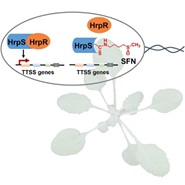When attacked by pathogenic microbes, plants protect themselves by deploying numerous secondary metabolites inhibitory to the pathogen. These metabolites are thought to nonspecifically inhibit both pathogenic and beneficial microbes, which is not desirable to plants.
A team led by ZHOU Jian-Min at Institute of Genetics and Development Biology of Chinese Academy of Sciences and LEI Xiaoguang at Peking University discovered a new mechanism by which a plant defense compound targets pathogenic bacteria without having deleterious effect on commensal bacteria.
Many Gram-negative pathogenic bacteria, such as Pseudomonas syringae, secretes virulence proteins into plant cells through a specialized protein secretion system, a process essential for pathogenicity. In this study, they identified sulforaphane, a natural product produced by cruciferous plants, covalently attaches to a specific residue of a bacterial protein that is needed to express genes encoding the secretion system. As such the metabolite specifically decreases virulence of the pathogenic bacteria and protects plants. This metabolite does not affect commensal bacteria, as the target protein only exists in the pathogen.
This study demonstrated that plants do possess “smart” chemical that attacks enemy without harming friends, which has not been discovered before.
The work has been published online in Cell Host & Microbe on April 8, 2020. Dr. WANG Wei and YANG Jing are the co-first authors of the paper. The work was supported by National Natural Science Foundation of China, the State Key Laboratory of Plant Genomics and the Joint Scientific Thematic Research Programme Grant.
Figure1. Model for the SFN-mediated repression of virulence gene expression in the bacterial pathogen. (Image by IGDB)
Contact:
Prof. ZHOU Jian-Min
Institute of Genetics and Developmental Biology, Chinese Academy of Sciences, Beijing China
 Figure1. Model for the SFN-mediated repression of virulence gene expression in the bacterial pathogen. (Image by IGDB)Contact:Prof. ZHOU Jian-MinInstitute of Genetics and Developmental Biology, Chinese Academy of Sciences, Beijing ChinaEmail: jmzhou@genetics.ac.cn
Figure1. Model for the SFN-mediated repression of virulence gene expression in the bacterial pathogen. (Image by IGDB)Contact:Prof. ZHOU Jian-MinInstitute of Genetics and Developmental Biology, Chinese Academy of Sciences, Beijing ChinaEmail: jmzhou@genetics.ac.cn CAS
CAS
 中文
中文




.png)
